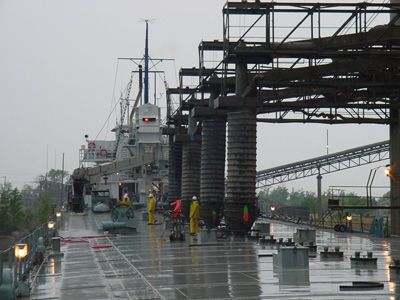 The Cement is loaded from an elevator using these large hose-shaped chutes. After loading the deck is washed with a vinegar acid solution to neutralize the corrosive alkalines in the cement dust.
The Cement is loaded from an elevator using these large hose-shaped chutes. After loading the deck is washed with a vinegar acid solution to neutralize the corrosive alkalines in the cement dust.
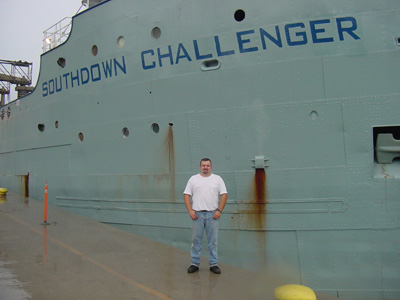 Here I am standing at the bow of the Southdown Challenger, the oldest ship operating on the Great Lakes. Built in 1906 it is relatively small by today's standards at 530 feet long. It carries powdered cement from its home port of Charlevoix Michigan to points all around the Great Lakes. I was lucky enough to take a trip aboard the Challenger with a little help from a couple friends.
Here I am standing at the bow of the Southdown Challenger, the oldest ship operating on the Great Lakes. Built in 1906 it is relatively small by today's standards at 530 feet long. It carries powdered cement from its home port of Charlevoix Michigan to points all around the Great Lakes. I was lucky enough to take a trip aboard the Challenger with a little help from a couple friends.
 The Cement is loaded from an elevator using these large hose-shaped chutes. After loading the deck is washed with a vinegar acid solution to neutralize the corrosive alkalines in the cement dust.
The Cement is loaded from an elevator using these large hose-shaped chutes. After loading the deck is washed with a vinegar acid solution to neutralize the corrosive alkalines in the cement dust.
This is an older steam ship having steam-powered winches on deck. While there are still many steam-powered vessels on the Great Lakes, only a precious few still have such antiquated features as steam winches.
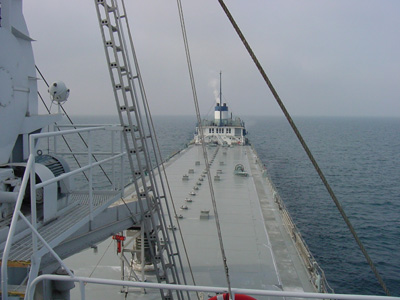 Once loaded we steamed out of Charlevoix Harbor into Lake Michigan heading south for Chicago. Our cruising speed was 11 mph, and for an entire day we saw no land and no other vessels. It's lonely and very peaceful out there - especially on a steamer, because they run smoothly and quietly without the rumble of diesel engines found on more modern ships.
Once loaded we steamed out of Charlevoix Harbor into Lake Michigan heading south for Chicago. Our cruising speed was 11 mph, and for an entire day we saw no land and no other vessels. It's lonely and very peaceful out there - especially on a steamer, because they run smoothly and quietly without the rumble of diesel engines found on more modern ships.
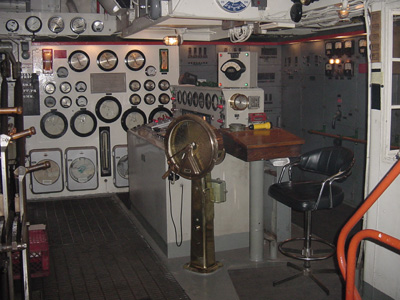 The engine room is full of gear, most of which is steam powered. In the center of the picture you can see the brass "Chadburn" telegraph. Commands from the pilot house are echoed here on this device. A bell rings in the chadburn when the command changes and the engineer on duty will open and close steam valves to implement the desired propulsion request. Chadburns are still in use today, but with the advent of diesel engine controls, such equipped boats can be controlled directly from the pilot house without assistance from the engineer. This is welcomed technology, especially when navigating tight rivers like the Calumet in Chicago where engine response time is critical.
The engine room is full of gear, most of which is steam powered. In the center of the picture you can see the brass "Chadburn" telegraph. Commands from the pilot house are echoed here on this device. A bell rings in the chadburn when the command changes and the engineer on duty will open and close steam valves to implement the desired propulsion request. Chadburns are still in use today, but with the advent of diesel engine controls, such equipped boats can be controlled directly from the pilot house without assistance from the engineer. This is welcomed technology, especially when navigating tight rivers like the Calumet in Chicago where engine response time is critical.
 This is a Skinner Unaflow steam engine. It is very much like a triple-expansion piston steam engine (as seen in Titanic) but instead of having three or four huge pistons, it has more pistons of smaller size that fit inside this enclosure.
This is a Skinner Unaflow steam engine. It is very much like a triple-expansion piston steam engine (as seen in Titanic) but instead of having three or four huge pistons, it has more pistons of smaller size that fit inside this enclosure.
Here you can see a camshaft opening and closing the steam valves that power the pistons.
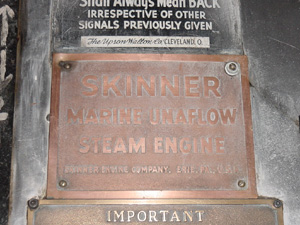 A proud piece of antiquity. The only other remaining Skinner Unaflow on the Great Lakes is in the SS Badger, a 410' car ferry that runs between Manitowoc, WI and Luddington, MI (the other steamers are equipped with steam turbine engines). The Badger is the only coal-fired steamer operating on the Great Lakes. All others burn oil in their boilers. The Southdown Challenger burns #6 fuel oil.
A proud piece of antiquity. The only other remaining Skinner Unaflow on the Great Lakes is in the SS Badger, a 410' car ferry that runs between Manitowoc, WI and Luddington, MI (the other steamers are equipped with steam turbine engines). The Badger is the only coal-fired steamer operating on the Great Lakes. All others burn oil in their boilers. The Southdown Challenger burns #6 fuel oil.
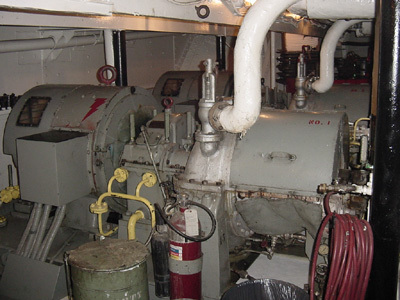 This is steam turbine AC electric generator. It is the loudest piece of machinery on the boat, and there are two of them.
This is steam turbine AC electric generator. It is the loudest piece of machinery on the boat, and there are two of them.
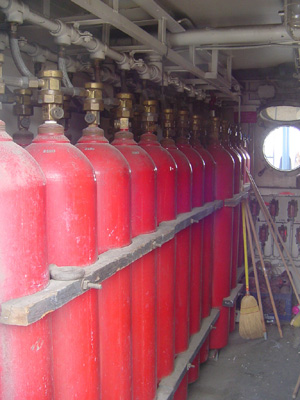 The ship has its own fire containment system that flushes the engine room with carbon dioxide gas to extinguish a fire by replacing all the oxygen with CO2. Before that can be done the engine room must be evacuated and sealed off, or any occupants would be extinguished along with the flames.
The ship has its own fire containment system that flushes the engine room with carbon dioxide gas to extinguish a fire by replacing all the oxygen with CO2. Before that can be done the engine room must be evacuated and sealed off, or any occupants would be extinguished along with the flames.
 The wheelhouse of the Challenger is large enough to fit several people, but small enough to be cozy for one.
The wheelhouse of the Challenger is large enough to fit several people, but small enough to be cozy for one.
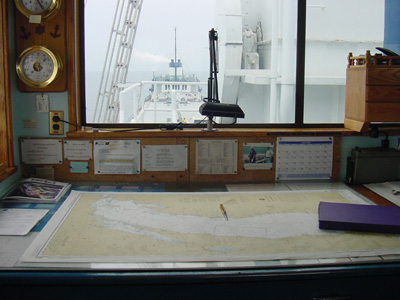 Despite access to modern technology like GPS, much of the route is planned with conventional navigation charts. They are still the definitive source for navigational features and hazards.
Despite access to modern technology like GPS, much of the route is planned with conventional navigation charts. They are still the definitive source for navigational features and hazards.
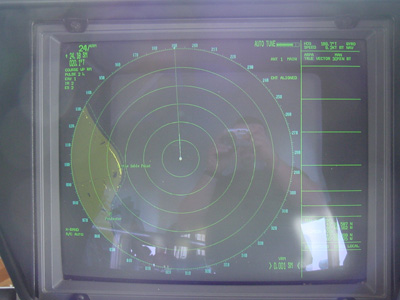 The Radar unit integrates computerized navigation charts with the radar image for a combined display.
The Radar unit integrates computerized navigation charts with the radar image for a combined display.
 You-know-who at the wheel of a 20-thousand-ton boat.
You-know-who at the wheel of a 20-thousand-ton boat.
Click here to put the skipper in motion.
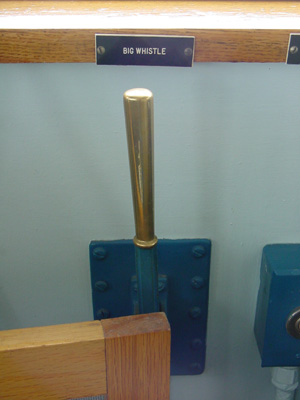 This...
This...
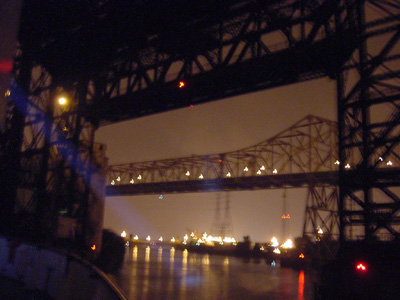 In the wee hours of the morning we enter Chicago's Calumet River. We are passing under a railroad draw bridge and just about to pass under the Chicago Skyway I-94 bridge.
In the wee hours of the morning we enter Chicago's Calumet River. We are passing under a railroad draw bridge and just about to pass under the Chicago Skyway I-94 bridge.
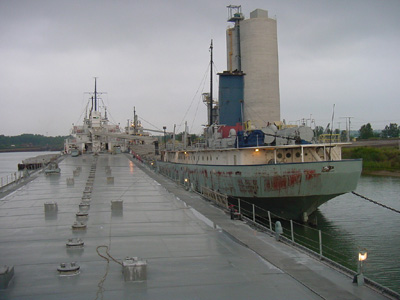 At daybreak we tie up at the Southdown terminal. the dock is actually a retired steamer called CTC#1. She is used as surplus storage for the cement and so we unload directly into her cargo holds.
At daybreak we tie up at the Southdown terminal. the dock is actually a retired steamer called CTC#1. She is used as surplus storage for the cement and so we unload directly into her cargo holds.
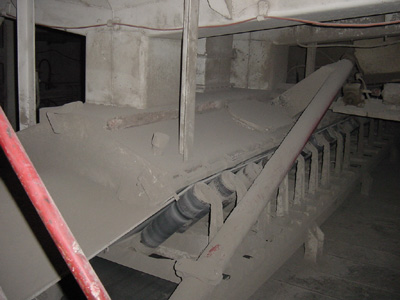 This conveyor system runs the length of the ship underneath the cargo holds. A gate opens allowing the cargo to fall down onto the conveyor which transports it to the front of the boat where it is elevated (by squeezing the powder between two vertical moving belts) and discharged through a large hose.
This conveyor system runs the length of the ship underneath the cargo holds. A gate opens allowing the cargo to fall down onto the conveyor which transports it to the front of the boat where it is elevated (by squeezing the powder between two vertical moving belts) and discharged through a large hose.
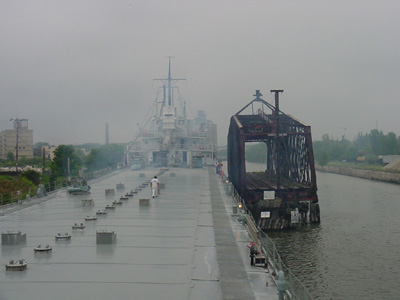 We depart chicago late that night and arrive in the Milwaukee harbor early the next morning to unload the remaider of our cargo. We squeek through a very narrow passage past this rotating rail bridge to get to the Southdown's Milwaukee terminal on the Kinnickinnic River.
We depart chicago late that night and arrive in the Milwaukee harbor early the next morning to unload the remaider of our cargo. We squeek through a very narrow passage past this rotating rail bridge to get to the Southdown's Milwaukee terminal on the Kinnickinnic River.
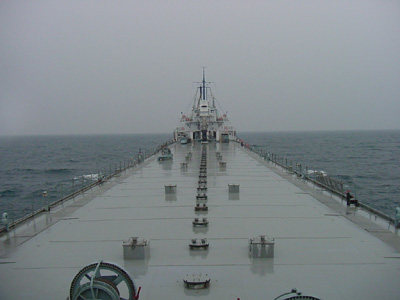 Later that afternoon we head back out into Lake Michigan for the return trip to Charlevoix.
Later that afternoon we head back out into Lake Michigan for the return trip to Charlevoix.
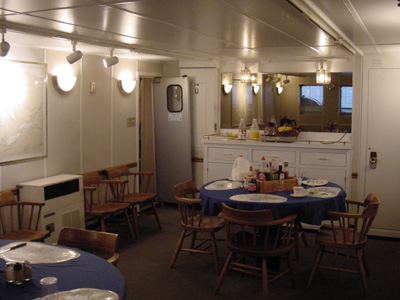 This is the Officer's Mess, where the officers, licensed crewmen (and visitors) eat their meals. They work 4 hours on duty and 8 hours off, twice a day. The meals are a welcomed break from the monotony of life at sea.
This is the Officer's Mess, where the officers, licensed crewmen (and visitors) eat their meals. They work 4 hours on duty and 8 hours off, twice a day. The meals are a welcomed break from the monotony of life at sea.
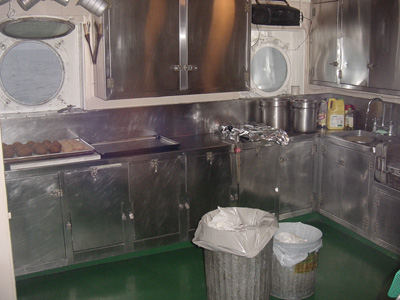 The ship's galley is the most efficient use of space I have ever seen. They have stuff packed in everywhere.
The ship's galley is the most efficient use of space I have ever seen. They have stuff packed in everywhere.
We arrive back at the Southdown Pier in Charlevoix. As the boat eases along the pier, the Bosun lowers deckhands to the dock to attach the mooring lines. Just like in the old days, they are swung over the side on this "Bosun's Chair."
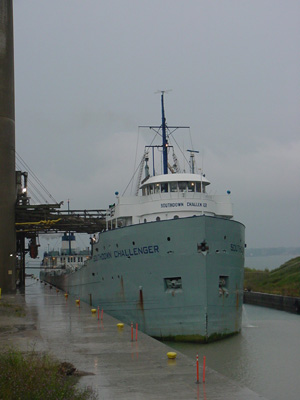 And a fascinating trip comes to an end.
And a fascinating trip comes to an end.
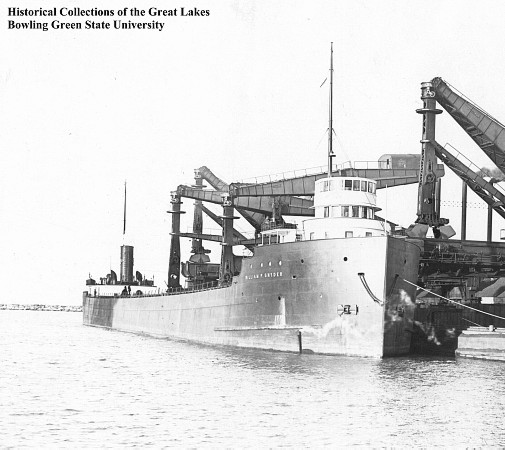 The Challenger was originally christoned as the Williwm P. Snyder. This is a historical photograph of her from the Great Lakes archive at Bowling Green State University. Although some boats retain the same name for their entire lifespan, it is quite common for ships to change names several times throughout their carreers. They are often renamed when a vessel is bought or sold.
The Challenger was originally christoned as the Williwm P. Snyder. This is a historical photograph of her from the Great Lakes archive at Bowling Green State University. Although some boats retain the same name for their entire lifespan, it is quite common for ships to change names several times throughout their carreers. They are often renamed when a vessel is bought or sold.
For example, the Southdown Challenger used to be called the Medusa Challenger until Medusa Cement Co. was bought out by Southdown Cement Co. It is rather uncommon for just a part of the name to change, however, usually the entire name is changed. It is also much more common for vessels to be named after people (often company presidents, their family members and so on.) Click here to look up boat histories.